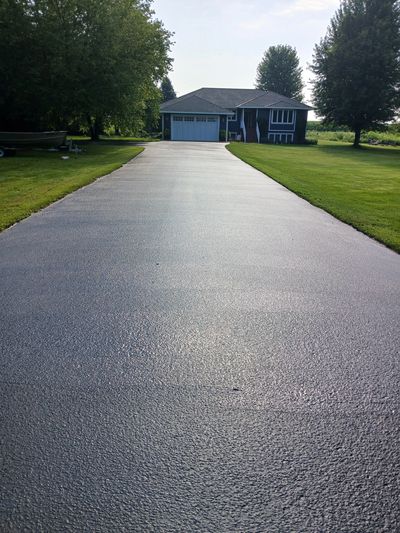Check out our discount rates (under Services Page)!!
Residential Sealcoating

What is sealcoating?
Residential sealcoating is the process of applying a protective layer to asphalt driveways to preserve and extend their lifespan. Over time, exposure to sunlight, moisture, oil, and chemicals can cause asphalt to crack, fade, and deteriorate. Sealcoating acts as a barrier against these damaging elements, helping to prevent oxidation and water penetration while restoring the surface’s original dark, smooth appearance.
This maintenance service not only improves curb appeal but also reduces the likelihood of costly repairs in the future. Typically recommended every 2–3 years, residential sealcoating is an affordable and effective way to protect your investment and keep your driveway looking like new.
What are the benefits to sealcoating?
Sealcoating offers a range of benefits that help homeowners protect and maintain their asphalt driveways. One of the primary advantages is protection against the elements—UV rays, rain, snow, and ice can all cause asphalt to crack and break down over time. Sealcoating creates a protective barrier that repels water and resists damage from oil, gasoline, and other automotive fluids.
In addition to protection, sealcoating enhances the visual appeal of your driveway by restoring its rich, black finish, giving your home a well-maintained and polished look. It also helps fill in surface imperfections and minor cracks, providing a smoother surface. Long-term, regular sealcoating can extend the life of your driveway and reduce the need for costly repairs or replacement, making it a smart and cost-effective maintenance practice.
What are the limitations of sealcoating?
While sealcoating provides valuable protection and aesthetic benefits, it’s important to understand its limitations. Sealcoating is not a permanent fix for major asphalt issues such as deep cracks, potholes, or structural damage. It’s a preventative maintenance measure, not a repair solution. Any significant damage to the asphalt should be repaired before sealcoating is applied to ensure the best results.
Additionally, sealcoating is a temporary treatment that gradually wears away due to traffic and weather exposure. It typically needs to be reapplied every 2–3 years to maintain its effectiveness. The process is also weather-dependent, requiring dry conditions and moderate temperatures for proper application and curing. Understanding these limitations helps homeowners set realistic expectations and incorporate sealcoating into a broader maintenance plan.
Schedule your free estimate today!
This website uses cookies.
We value your privacy
We use cookies to enhance your browsing experience, serve personalized content, and analyze our traffic. By clicking "Accept All", you consent to our use of cookies. You can manage your cookie preferences or learn more by visiting our Cookie Policy.
